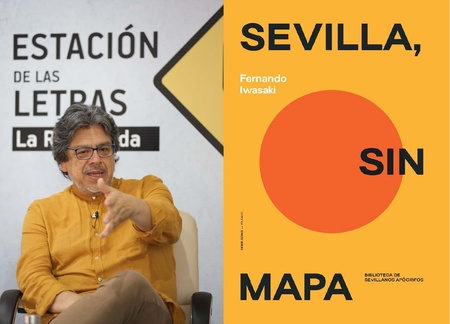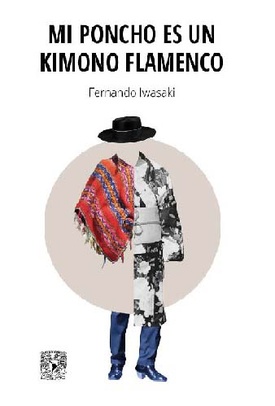Anchored more than 25 years ago in a town in Seville, the Peruvian writer Fernando Iwasaki (Lima, 1961) could have disappeared from the radar of bookstore news if it were not for his active role as a historian, the subject of his professional training and the shore from which he usually writes essays and books that float between the historical and literary, such as the recent Brevetes de historia universal del Perú (Alfaguara, 2021).
“I must admit that I do not consider it a history book. It is not a story book either. "It was about writing with literary ambition about historical figures," responds via email, from the town of San José de la Rinconada, a disconnected Iwasaki, whose bucolic days are similar to those of some of his characters from past centuries: politicians, artists and Peruvian combatants whose days are related to historical events, as yours may be related to the current persistent pandemic.
“I have lived in the countryside since 1997. Without neighbors and three kilometers from the nearest urban area. We do not have drinking water, we produce our own energy with solar panels and we have a farm with a garden and fruit trees. That is to say, the confinement did not represent a big change in my life,” says Iwasaki, who, by choice, does not read the Peruvian press, does not know who the ministers of the current government are and does not watch the soccer team matches, like a castaway who enjoys an island full of books.
Brief and secondary
If there is something that keeps Iwasaki tied to current events, it is literature. “I try to read what Peruvian authors that I love and admire write, I rescue forgotten Peruvian writers and I reread our classics to connect them with other classics; Not to mention the excitement that makes me find the trace of Peru or Peruvian references anywhere on the planet,” notes Iwasaki, who for his most recent book brought together dissimilar characters: a privateer, a saint, a singing teacher, a subversive.
In short literary style prose, “all the protagonists of these stories are part of the history of our country. “They are all Peruvians and, therefore, they have the same destiny: a difficult relationship with the rest of the universe,” noted the Peruvian novelist Alonso Cueto. “Iwasaki makes us see how, in a deliberate or unconscious way, the Peruvian characters connect with the rest of the universe.” 1
The soprano Yma Sumac, the indigenous leader Pedro Pablo Atusparia, the navigator Isabel Barreto and the Jesuit priest Antonio Ruiz de Montoya appear in this compilation of characters reminiscent of Chesterton's “Brief History of England.” In that book, the British philosopher justified his daring to write an essay on the “little story” by indicating that no one had done it from the public's point of view. “What we usually call popular stories should rather be called anti-popular.” Iwasaki chooses to save secondary characters from oblivion instead of the marble heroes.
Literary history
Are history books more popular in the digital age? Iwasaki declares himself incapable of defining these market trends, although he is very aware of the literary currents that have been influencing Latin American writers such as Katya Adaui, Mónica Ojeda, Liliana Colanzi, Valeria Luiselli, Lina Meruane and Samantha Schweblin. Recently, Iwasaki was invited to the “ XXVII Colloquium of Literature Students ”, at the Pontifical Catholic University of Peru, to talk about horror literature.
Instead of talking about her most terrifying work ( Ajuar funerario , published 18 years ago), Iwasaki preferred to review contemporary Latin American writers who have tackled stories that move away from classic horror (that of Poe or Lovecraft) to address fear. from other perspectives. To those mentioned above, he added the names of María Fernanda Ampuero, Giovana Rivero, Fernanda Melchor, Socorro Venegas, Alejandra Costamagna, Karina Sainz Borgo and Mariana Enríquez.
“An enumeration of young and splendid Latin American writers who today are the literary reference in our language. They work on the unusual, on different texts that touch on the fantastic and wonderful,” he says, continuing the list with the names of Natalia Álvarez, Andrea Maturana, Cecilia Eudave and Valeria Correa Fiz. In the history of Latin American literature, for Iwasaki the female voice is indisputable.
path to the past
Iwasaki, who collaborates with media such as El País Semanal, ABC de Sevilla and Jot Down magazine, also lives outside digital tools. He does not use blogs, does not have accounts on social networks, nor does he follow literature podcasts, although he is sometimes invited to participate in them . “I live oblivious to all that. And not because of lack of interest, but because of digital clumsiness. When my daughters visit me, I ask them to play podcasts, because I don't know how to reach them.”
Iwasaki also participates in some radio programs and teaches classes at the Loyola Andalusia University, where he learned to contact each other online and record his classes during the quarantine. During the confinement, his grandson was also born, “we all met in the field, we saw the baby being born and we accompanied each other,” says the writer, who took advantage of those months of isolation to read more than to write.
Its editors, on the other hand, did take advantage of the reissues of books such as Mi poncho es un kimono flamenco (UNAM, 2021), partially published by the Sarita Cartonera publishing house in 2005. This set of essays that address the identity of the author is divided into “Poncho”, “Kimono” and “Flamenco”, cultural underworlds (Peruvian, Nikkei and Spanish) that are part of the origin, history and present of an author whose book has been described as “full of intelligence, humor, understanding And joy". 2
Of the past and future
This year, El atelier de Vercingétorix was also republished in Costa Rica, through Encino Ediciones, an anthology of stories that make Iwasaki an author of the past, for his history books, and of the future, for the projection that the set of his work. “I have a book of short stories and two novels pending publication, but I am slow at writing. That's why I haven't published fiction since 2009, although I must admit that, for me, a book of essays is as important or more important than a novel."

Far from Peru, to which he returns once a year for a few days, the most Hispanicized Nikkei writer (in 2021 Seville without a map was also republished, published by Serie Gong Editorial, a library of characters connected to Seville, such as Jorge Luis Borges and Roberto Bolaño, also available in audiobook) has just turned 61 and his Japanese surname continues to be heard in Peruvian media and Spanish radio Onda Cero. A few years ago, from Beijing, Iwasaki declared “miscegenation is the best antidote to radicalism.” 3

In 2019, when he wrote the text that opens his book Brevetes de historia universal del Perú , which includes an epigraph by the poet José Watanabe, he noted: “Today I turned 58 years old, the same age that José María Arguedas was when he decided not to prolong even a day more its existence.” In the year the pandemic began, Iwasaki perceived the fate of so many Peruvian literary talents who died young when he sought to recover the homeland of his books. Those of classics such as José Carlos Mariátegui and Abraham Valdelomar, but also those of Peruvians of this century such as Pilar Dughi and Eduardo Chirinos.
This year, to celebrate his wife's birthday, Fernando traveled with her to southern Italy to tour Pompeii and Herculaneum. “We will look for the Naples of Montesano and Walter Benjamin,” confesses Iwasaki, an expert in following the trail of memorable figures through so many cities and countries, along the paths of the past that have led him to the life of Francisca Pizarro or Peter Dennis Daly, the Englishman who lived in Lima and who survived the sinking of the Titanic. Who knows if from this trip a new literary historical rescue will emerge from the oceans of archives where flamenco Nikkei usually dives like a fish in a library.
Grades:
1. Alonso Cueto, “ Supaypa wawa, Clark Gable; by Alonso Cueto ”, El Comercio , August 13, 2021.
2. Bernat Castany Prado, “ The smile recovered in Fernando Iwasaki Cauti ”, Zenda , May 8, 2022.
3. “ Fernando Iwasaki: 'Mestizaje is the best antidote to radicalism' ”, La Vanguardia , April 22, 2019.
© 2022 Javier García Wong-Kit







